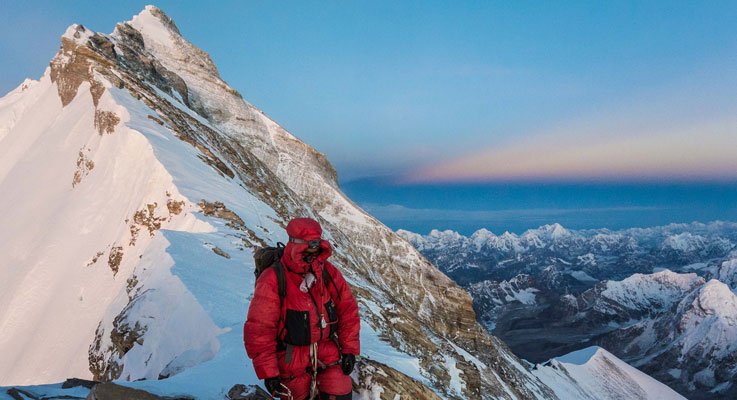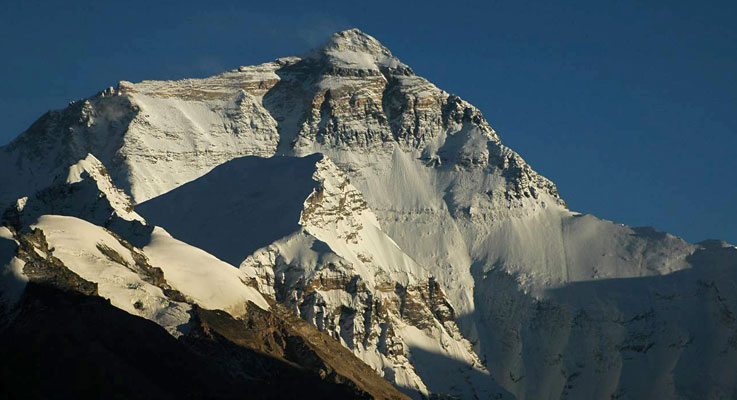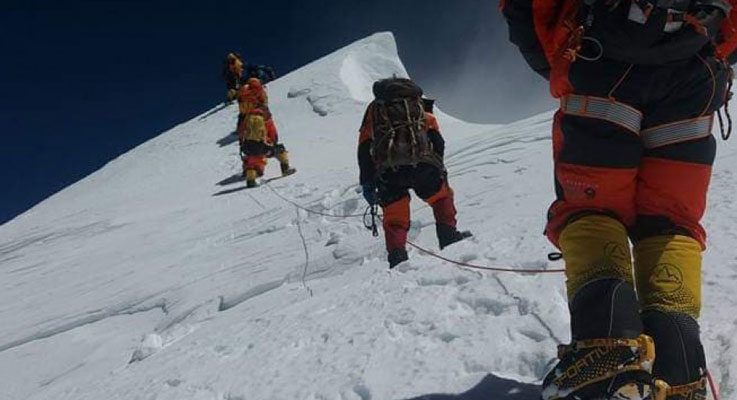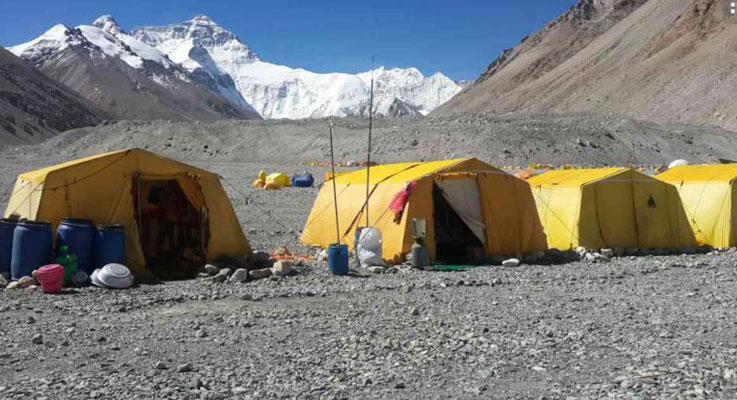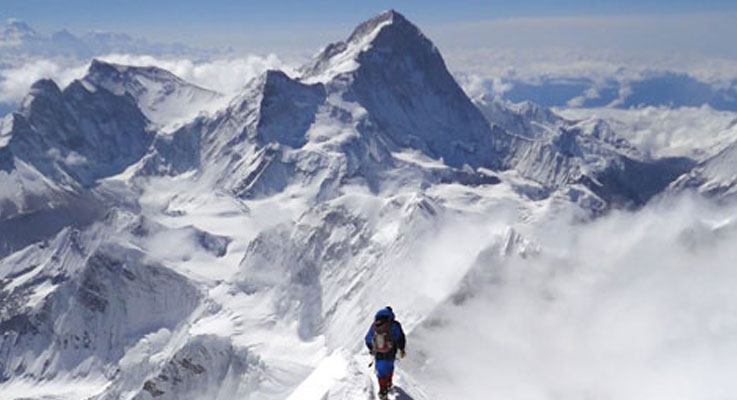-
Day 1
Arrival in Kathmandu (1,345m/4,413 ft)
Upon arriving at Tribhuwan International Airport in Kathmandu, you will be received by our airport representatives who will warmly greet you and transfer to the hotel on a private tourist vehicle. We provide 3-star accommodation in the city and we arrange for a trip briefing with dinner in the evening.
-
Day 2
Visit old town of Kathmandu
A professional guide and vehicle are provided for a day of sightseeing in and around Kathmandu city. We visit some of the UNESCO World Heritage Sites in the city along with other interesting cultural monuments that dot the valley. These include Boudhanath Stupa (the largest Buddhist shrines in the world), Pashupatinath (the holiest Hindu temple in the world), Durbar Squares (Palaces and fortresses of medieval Kings), along with other popular cultural attractions. We get to observe the lifestyle of Nepalese people, holy sadhus and monks, fascinating history as well as awe-inspiring architecture.
-
Day 3
Official formalities in Kathmandu
Formal briefing at the Ministry of Tourism. The expedition leader will check that everyone’s equipment is in working order.
-
Day 4
Final preparation day in Kathmandu
Final opportunity for last-minute purchases.
-
Day 5
Fly to Lhasa
Early morning transfer to the Kathmandu International Airport for the hour-long flight to Lhasa. This stunning flight takes us directly across the main Himalayan range, providing magnificent mountain views. After landing at Gonggar Airport and meeting our Tibetan guide, Lhasa is a further two hour drive. The remainder of the day will be left unscheduled for participants to rest and adjust to Lhasa's higher altitude. Overnight at Lhasa hotel.
-
Day 6
Sightseeing in Lhasa
We spend today visiting several of Lhasa's many monasteries in the company of a guide and interpreter. One of these is the Sera Monastery, one of the best-preserved monasteries in Tibet. Several hundred monks live and study within its whitewashed walls and golden roofs. After lunch we'll visit the Norbulingka, the summer palace of the Dalai Lama, as well as the Jokhang Temple. This temple is possibly the most sacred shrine in Tibet and there is always a procession of devout Tibetans making their way through the complex. Surrounding the Jokhang is the Barkor, a maze of narrow cobbled streets that is the central market of Lhasa. Overnight at Lhasa hotel.
-
Day 7
Second day of sightseeing in Lhasa
In the morning, we visit spectacular Potala Palace, which dominates the city of Lhasa. The building served as the seat of the Dalai Lama from the 17th century until 1959, and contains numerous grand state rooms and many important chapels. After lunch we visit the Drepung Monastery, founded in the 14th century and once the largest in the world, with a population of around 10,000 monks. These days that figure is down to several hundred, but there is still much at the monastery of interest, especially because it was left relatively unscathed during the Cultural Revolution. Overnight at Lhasa hotel.
-
Day 8
Drive to Gyantse
We begin the day’s 261 km journey heading towards Rongbuk Valley. Following the Friendship Highway, we cross the Khamba La at an elevation of 4794m, from where there are stunning views across the waters of Yamdrok-Tso Lake to the snowy summit of Nazin Kang Sa (7252m). As continue our journey west over another high pass, the Karo La (5045m), we can view the spectacular sight of a huge glacier tumbling down to within a few hundred meters of the road. After few hours we arrive in Gyantse (3950m), passing through beautiful valleys and colorful Tibetan villages. Overnight at Gyantse hotel.
-
Day 9
Drive to Shigatse
This morning we visit the GyantseDzong, a fort dating back to the fourteenth century that offers amazing views of Gyantse and the surrounding valleys. Before leaving we also visit the famed GyantseKumbum. This magnificent tiered structure is the largest stupa in all of Tibet. In addition to its exquisite golden dome, the stupa is filled with Tibetan sculptures and paintings.
We continue the 90 km trip to Shigatse (3900m), the second largest city in Tibet. Shigatse is a laid back city that provides excellent opportunities for relaxation and exploration. After exploring the local market we will visit the Tashilhunpo Monastery, one of the largest functioning monasteries in Tibet. Overnight at Shigatse hotel.
-
Day 10
Drive to Xegar (New Tingri)
The views offered by this desert plateau provide wonderful entertainment as we travel 244km along the Friendship Highway on our way to Xegar (4050). This stretch runs through Tibet’s most spectacular landscape. After passing through the small town of Lhatse we will cross Gyatmso La – with an elevation of 5220m, it is the highest pass on our journey. The land quickly descends to plains after Gyatmso La. While travelling through the plains we will see nomadic herders, quiet countryside, and secluded monasteries. Overnight at Xegar hotel.
-
Day 11
Drive to Ronguk and hike to Everest Base Camp
Today we leave the main Lhasa-to-Kathmandu highway and head due south toward Mt. Everest. We drive over the Pang La, which should provide our first good view of Everest, some 40 miles away. Then we descend to a village on the valley floor, continuing up the valley to the base camp (5150m). The road becomes increasingly rough, but the scenery grows all the more stunning as we round each corner. Finally we come to the awesome north face of Everest at the head of the valley before us. From the base camp it certainly seems very close, but it is still another twelve miles away. Overnight at tented camp.
-
Day 12-16
Acclimatization and local exploration
Four days will be spent at the base camp while our bodies adapt to the high altitude, allowing plenty of time to enjoy the views and photograph Everest. For those feeling up to it, there are plenty of hillsides to scramble up, and Rongbuk Monastery lays an eight kilometer (five mile) walk down the valley. Another sight not to miss is Tillman's Camp, an idyllic spot beside the majestic Central Rongbuk Glacier, which offers staggering views of the north side of Everest. While there’s plenty to see in the valley, it’s important not to overdo it during this period - there will be plenty of opportunity for exertion later. At this phase of the expedition, climbers should be adapting to the altitude, drinking plenty of fluids, resting, and enjoying the cuisine of the Sherpa cooking staff. Overnight at tented camp.
-
Day 17
Trek to first interim camp
The trek starts easily enough, crossing the pebble floodplain of the Rongbuk River, then weaving along a path between the glacier and the valley side. After about 2 hours we reach a good viewpoint and turn steeply up to the left, leaving the main central Rongbuk valley. This takes us up into what seems to be a fairly small subsidiary valley, but it soon opens up to reveal the amazing pinnacles of the East Rongbuk Glacier. It was the discovery of this path in 1922 that provided the key to climbing the north side of Everest. After no more than two hours since leaving the Rongbuk Valley, we make camp in a pleasant spot with plenty of space (5680m). The camp is located on the right bank, overlooking the river below, and is just short of the moraines and the toe of the glacier that lay ahead. Overnight at tented camp.
-
Day 18
Trek to second interim camp
Crossing small streams and moraines, we gain the opposite side of the valley and contour along it until the valley makes a definite swing north.
This will be the site of our interim camp for future journeys between base and advance base, but for now it marks the climb onto the glacier proper and the start of the Magic Highway. On subsequent journeys up the East Rongbuk Glacier, we will be fitter and better acclimatized, enabling us to complete the trek easily in two days.
The Magic Highway is a unique tongue of moraine that passes down the middle of the treacherous ice pinnacles of the East Rongbuk Glacier. The route is surprisingly level, with little height gain; most of the effort goes into adapting to the altitude change.
Once on the Magic Highway, the conditions become more difficult than during the previous day's walk, with ice and moraine constant companions from here onward. At the start of the season, the streams on the glacier will be slight, carrying little water. However, as the season progresses through spring, and toward summer, some of these streams will become torrents, requiring frequent route changes to cross them safely.
The highway eventually drifts in toward the east ridge of Changtse, where a lake often forms. The interim camp, reached after five hours of slow walking, is nestled close to the entrance of the cwm to the north of Changtse, close to this moraine lake. Overnight at tented camp.
-
Day 19
Trek to advance base camp
The reappearance of Everest is a pleasant distraction during the final climb, and as you round the corner toward the advance base camp (6440m) the whole northeast ridge can be seen, from the Raphu La to the summit. The shimmering triangle of snow highlighting the summit four kilometers away and two up will issues its siren’s call until your footsteps cross it! Overnight at tented camp.
-
Day 20-58
Climbing Mt. Everest from north ridge
From this point on, it’s not really possible to detail a climbing plan, because the pace will depend upon the leader and the particular team. For those who have experienced extreme altitude before, we aim to be as flexible as possible to allow for each climber’s preferred acclimatization routine. For some, this may mean climbing as high as Camp 3 on the north ridge as quickly as possible, before diving back to the base camp for a long rest. Others might want to remain at a lower altitude longer, taking several trips to the North Col and sleeping there overnight but not going any higher at the start.
Whatever routine is adopted for acclimatization, once everyone is happy that they have achieved an optimum state of readiness, the team will return to the base camp for a long period of rest and refreshment.
After many days of resting and preparing, we return once more to ABC, using the single interim camp at the start of the Magic Highway. Again, we pause in ABC, to refresh and check equipment. When the weather is as fair as possible we head up. The route to the North Col is by now a well-known path, since we have ascended and descended its slopes a few times as part of our acclimatization process. We’ll also find the meters slipping by more easily, with our sights now set on the mountain’s pinnacle.
From Camp 1 on the North Col, the route turns to follow a long snow ramp, the north ridge proper, which rests like a gigantic flying buttress supporting the upper reaches of the mountain. Although this stretch never grows steep, it is prone to wind sweeping icily across the mountain. After a full day we reach Camp 2, located at the head of the ramp.
From here the route moves on to broken rocky ground of shattered shale, as the north ridge casts off its layers of snow. The route remains relatively easily-angled, although the gradient increases gently until the next camp is reached. This camp is located where the mass of the north ridge rams home hard against the bulk of the mountain, on rocky shelves. The day’s trek is rewarded with stunning views over the glaciers below. What we viewed as large mountains towering above on the Magic Highway are now below, blending into the backdrop of the Tibetan Plateau and the flatlands beyond.
The top camp will give you an even greater sense of the world below your feet. The ascent continues on broken ledges, but these are easy to navigate, interlaced with shale and scree until snow runnels give out onto the north face proper. Once clear of the rocks and on more open slopes, you turn directly upwards, to arrive at the final camp at about 8,400 metres.
Summit day
Summit day begins before midnight! Leaving the tents in the still of the night, you clamber up a faint gully that leads to the ridge above. This line through the rocks is steeper than those traversed the day before, but the fixed ropes help lift you toward the skyline. Some scrambling will land you on the ridge at over 8,500 meters. The only thing now between you and the top is roughly 400 meters of ascent, three rock steps, and over a kilometer of ridge - the ultimate tightrope! As dawn breaks, you will see the awesome Kangshung Face falling off to your left - a mind-boggling drop into Tibet. For the main section, you remain on the right flank and traverse easily in places, but the route is punctuated by the first, second and third steps. The hardest of these is the second, which has a ladder and fixed rope to allow an ascent, which would be virtually impossible otherwise. Additionally, you can expect an airy traverse en route to gaining the top. Finally, you step onto the mountain yields and final summit snowfield previously witnessed from miles below, heralding your arrival to the Top of the World.
-
Day 59
Packing personal equipment at base camp
Overnight at tented camp
-
Day 60
Depart from base camp and drive to Zangmu
We return by the same remarkable road journey across the Tibetan plateau, staying the in Zangmu and preparing to cross back into Nepal at first light. Overnight at hotel.
-
Day 61
Drive to Kathmandu
Once back in Kathmandu, we will toast a drink or two to celebrate the expedition, say farewell, and thank the Sherpas and team members for their support and friendship throughout the trip. Overnight at Kathmandu hotel.
-
Day 62
Leisure day in Kathmandu
Leisure day in Kathmandu.Overnight at Kathmandu hotel.
-
Day 63
Transfer to airport for flight departure
Our staff will escort you to Kathmandu International Airport for your flight departure from Nepal.

